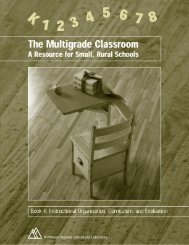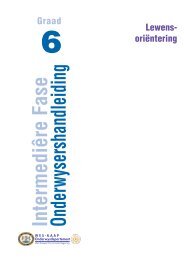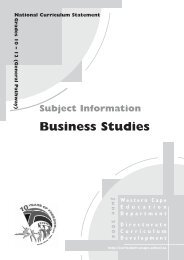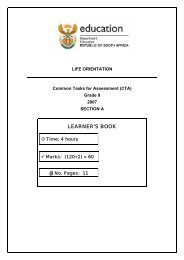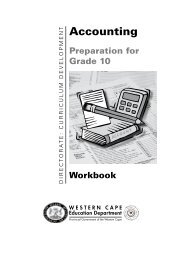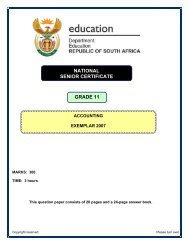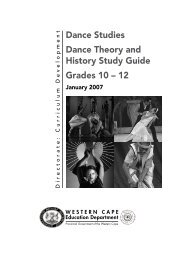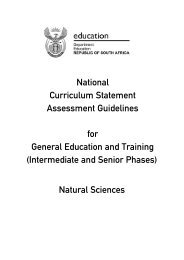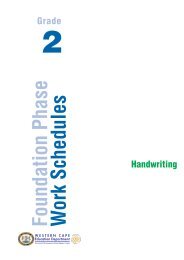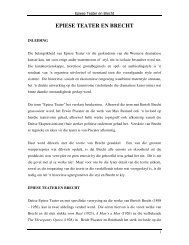Agricultural Sciences - SchoolNet South Africa
Agricultural Sciences - SchoolNet South Africa
Agricultural Sciences - SchoolNet South Africa
You also want an ePaper? Increase the reach of your titles
YUMPU automatically turns print PDFs into web optimized ePapers that Google loves.
NATIONAL CURRICULUMSTATEMENT GRADES 10-12(GENERAL)AGRICULTURALSCIENCES
National Curriculum StatementGrades 10 – 12(General)AGRICULTURAL SCIENCES
Department of EducationSol Plaatje House123 Schoeman StreetPrivate Bag X895Pretoria 0001<strong>South</strong> <strong>Africa</strong>Tel: +27 12 312-5911Fax: +27 12 321-6770120 Plein StreetPrivate Bag X9023Cape Town 8000<strong>South</strong> <strong>Africa</strong>Tel: +27 21 465-1701Fax: +27 21 461-8110http://education.pwv.gov.za© 2003 Department of EducationISBN 1-919975-63-2Design and Layout by: Seriti Printing (Pty) LtdPrinted for the Government Printer Pretoria by Shumani Printers
<strong>Agricultural</strong> <strong>Sciences</strong>HOW TO USE THIS BOOKThis document is a policy document divided into four chapters. It is important for the reader to read and integrateinformation from the different sections in the document. The content of each chapter is described below.■Chapter 1 - Introducing the National Curriculum StatementThis chapter describes the principles and the design features of the National Curriculum StatementGrades 10 – 12 (General). It provides an introduction to the curriculum for the reader.■Chapter 2 - Introducing the SubjectThis chapter describes the definition, purpose, scope, career links and Learning Outcomes of thesubject. It provides an orientation to the Subject Statement.■Chapter 3 - Learning Outcomes, Assessment Standards, Content and ContextsThis chapter contains the Assessment Standards for each Learning Outcome, as well as content andcontexts for the subject. The Assessment Standards are arranged to assist the reader to see the intendedprogression from Grade 10 to Grade12. The Assessment Standards are consequently laid out in doublepagespreads. At the end of the chapter is the proposed content and contexts to teach, learn and attainAssessment Standards.■Chapter 4 – AssessmentThis chapter deals with the generic approach to assessment being suggested by the National CurriculumStatement. At the end of the chapter is a table of subject-specific competence descriptions. Codes,scales and competence descriptions are provided for each grade. The competence descriptions arearranged to demonstrate progression from Grade 10 to Grade 12.■SymbolsThe following symbols are used to identify Learning Outcomes, Assessment Standards, grades, codes,scales, competence description, and content and contexts.c== Learning Outcome = Scale= Assessment Standard = Competence Description= Grade = Content and ContextsCodeSCdCiii
<strong>Agricultural</strong> <strong>Sciences</strong>CONTENTSHOW TO USE THIS BOOKACRONYMSiiiixCHAPTER 1: INTRODUCING THE NATIONAL CURRICULUM STATEMENT 1PRINCIPLES 1Social transformation 2Outcomes-based education 2High knowledge and high skills 3Integration and applied competence 3Progression 3Articulation and portability 3Human rights, inclusivity, environmental and social justice 4Valuing indigenous knowledge systems 4Credibility, quality and efficiency 4THE KIND OF LEARNER THAT IS ENVISAGED 4THE KIND OF TEACHER THAT IS ENVISAGED 5STRUCTURE AND DESIGN FEATURES 5Structure of the National Curriculum Statement 5Contents of Subject Statements 7LEARNING PROGRAMME GUIDELINES 7v
<strong>Agricultural</strong> <strong>Sciences</strong>CHAPTER 2: AGRICULTURAL SCIENCES 9DEFINITION 9PURPOSE 9SCOPE 10EDUCATIONAL AND CAREER LINKS 10LEARNING OUTCOMES 11Learning Outcome 1: Investigate and Analyse 11Learning Outcome 2: Sustainable <strong>Agricultural</strong> Practices 12Learning Outcome 3: Indigenous <strong>Agricultural</strong> Knowledge and Historical Development 13Learning Outcome 4: Interrelated Issues in Agriculture 13CHAPTER 3: LEARNING OUTCOMES, ASSESSMENT STANDARDS, CONTENT 16AND CONTEXTSASSESSMENT STANDARDS 16Learning Outcome 1: Investigate and Analyse 16Learning Outcome 2: Sustainable <strong>Agricultural</strong> Practices 18Learning Outcome 3: Indigenous <strong>Agricultural</strong> Knowledge and Historical Development 22Learning Outcome 4: Interrelated Issues in Agriculture 24CONTENT AND CONTEXT FOR THE ATTAINMENT OF ASSESSMENT STANDARDS 26vi
<strong>Agricultural</strong> <strong>Sciences</strong><strong>Agricultural</strong> <strong>Sciences</strong> Content 26CHAPTER 4: ASSESSMENT 31INTRODUCTION 31WHY ASSESS 31TYPES OF ASSESSMENT 32Baseline assessment 32Diagnostic assessment 32Formative assessment 32Summative assessment 32WHAT SHOULD ASSESSMENT BE AND DO? 33HOW TO ASSESS 33METHODS OF ASSESSMENT 34Self-assessment 34Peer assessment 34Group assessment 34METHODS OF COLLECTING ASSESSMENT EVIDENCE 34Observation-based assessment 34Test-based assessment 34Task-based assessment 35RECORDING AND REPORTING 35Methods of recording 35Reporting performance and achievement 36SUBJECT COMPETENCE DESCRIPTIONS 37vii
<strong>Agricultural</strong> <strong>Sciences</strong>PROMOTION 38WHAT REPORT CARDS SHOULD LOOK LIKE 38ASSESSMENT OF LEARNERS WHO EXPERIENCE BARRIERS TO LEARNING 38COMPETENCE DESCRIPTIONS FOR AGRICULTURAL SCIENCE 40GLOSSARY 53viii
<strong>Agricultural</strong> <strong>Sciences</strong>ACRONYMSAgriSAAIAIDSARCCASSDNADOFETGETHIVIKSIPMNAFUNAMPONCSNQFOBESAQA<strong>South</strong> <strong>Africa</strong>n <strong>Agricultural</strong> UnionArtificial InseminationAcquired Immune Deficiency Syndrome<strong>Agricultural</strong> Research CouncilContinuous AssessmentDeoxyribonucleic AcidDevelepmental OutcomeFurther Education and TrainingGeneral Education and TrainingHuman Immunodeficiency VirusIndigenous Knowledge SystemsInter-Pest ManagementNational <strong>Agricultural</strong> Farmers UnionNational Maize Producers OrganisationNational Curriculum StatementNational Qualifications FrameworkOutcomes-Based Education<strong>South</strong> <strong>Africa</strong>n Qualifications Authorityix
<strong>Agricultural</strong> <strong>Sciences</strong>x
<strong>Agricultural</strong> <strong>Sciences</strong>CHAPTER 1INTRODUCING THE NATIONAL CURRICULUM STATEMENTThe adoption of the Constitution of the Republic of <strong>South</strong> <strong>Africa</strong> (Act 108 of 1996) provided a basis for curriculumtransformation and development in <strong>South</strong> <strong>Africa</strong>. The Preamble states that the aims of the Constitution are to:■■■■heal the divisions of the past and establish a society based on democratic values, social justice andfundamental human rights;improve the quality of life of all citizens and free the potential of each person;lay the foundations for a democratic and open society in which government is based on the will of thepeople and every citizen is equally protected by law; andbuild a united and democratic <strong>South</strong> <strong>Africa</strong> able to take its rightful place as a sovereign state in the familyof nations.The Constitution further states that ‘everyone has the right … to further education which the State, throughreasonable measures, must make progressively available and accessible’.The National Curriculum Statement Grades 10 – 12 (General) lays a foundation for the achievement of thesegoals by stipulating Learning Outcomes and Assessment Standards, and by spelling out the key principles andvalues that underpin the curriculum.PRINCIPLESThe National Curriculum Statement Grades 10 – 12 (General) is based on the following principles:■■■■■■■■■social transformation;outcomes-based education;high knowledge and high skills;integration and applied competence;progression;articulation and portability;human rights, inclusivity, environmental and social justice;valuing indigenous knowledge systems; andcredibility, quality and efficiency.1
<strong>Agricultural</strong> <strong>Sciences</strong>Social transformationThe Constitution of the Republic of <strong>South</strong> <strong>Africa</strong> forms the basis for social transformation in our post-apartheidsociety. The imperative to transform <strong>South</strong> <strong>Africa</strong>n society by making use of various transformative tools stemsfrom a need to address the legacy of apartheid in all areas of human activity and in education in particular.Social transformation in education is aimed at ensuring that the educational imbalances of the past areredressed, and that equal educational opportunities are provided for all sections of our population. If socialtransformation is to be achieved, all <strong>South</strong> <strong>Africa</strong>ns have to be educationally affirmed through the recognitionof their potential and the removal of artificial barriers to the attainment of qualifications.Outcomes-based educationOutcomes-based education (OBE) forms the foundation for the curriculum in <strong>South</strong> <strong>Africa</strong>. It strives to enableall learners to reach their maximum learning potential by setting the Learning Outcomes to be achieved by theend of the education process. OBE encourages a learner-centred and activity-based approach to education. TheNational Curriculum Statement builds its Learning Outcomes for Grades 10 – 12 on the Critical andDevelopmental Outcomes that were inspired by the Constitution and developed through a democraticprocess.The Critical Outcomes require learners to be able to:■■■■■■■identify and solve problems and make decisions using critical and creative thinking;work effectively with others as members of a team, group, organisation and community;organise and manage themselves and their activities responsibly and effectively;collect, analyse, organise and critically evaluate information;communicate effectively using visual, symbolic and/or language skills in various modes;use science and technology effectively and critically showing responsibility towards the environment andthe health of others; anddemonstrate an understanding of the world as a set of related systems by recognising that problem solvingcontexts do not exist in isolation.The Developmental Outcomes require learners to be able to:■■■■■reflect on and explore a variety of strategies to learn more effectively;participate as responsible citizens in the life of local, national and global communities;be culturally and aesthetically sensitive across a range of social contexts;explore education and career opportunities; anddevelop entrepreneurial opportunities.2
<strong>Agricultural</strong> <strong>Sciences</strong>High knowledge and high skillsThe National Curriculum Statement Grades 10 – 12 (General) aims to develop a high level of knowledge andskills in learners. It sets up high expectations of what all <strong>South</strong> <strong>Africa</strong>n learners can achieve. Social justicerequires the empowerment of those sections of the population previously disempowered by the lack ofknowledge and skills. The National Curriculum Statement specifies the minimum standards of knowledge andskills to be achieved at each grade and sets high, achievable standards in all subjects.Integration and applied competenceIntegration is achieved within and across subjects and fields of learning. The integration of knowledge and skillsacross subjects and terrains of practice is crucial for achieving applied competence as defined in the NationalQualifications Framework. Applied competence aims at integrating three discrete competences – namely, practical,foundational and reflective competences. In adopting integration and applied competence, the National CurriculumStatement Grades 10 – 12 (General) seeks to promote an integrated learning of theory, practice and reflection.ProgressionProgression refers to the process of developing more advanced and complex knowledge and skills. The SubjectStatements show progression from one grade to another. Each Learning Outcome is followed by an explicitstatement of what level of performance is expected for the outcome. Assessment Standards are arranged in aformat that shows an increased level of expected performance per grade. The content and context of each gradewill also show progression from simple to complex.Articulation and portabilityArticulation refers to the relationship between qualifications in different National Qualifications Framework levels orbands in ways that promote access from one qualification to another. This is especially important for qualificationsfalling within the same learning pathway. Given that the Further Education and Training band is nested between theGeneral Education and Training and the Higher Education bands, it is vital that the Further Education and TrainingCertificate (General) articulates with the General Education and Training Certificate and with qualifications in similarlearning pathways of Higher Education. In order to achieve this articulation, the development of each SubjectStatement included a close scrutiny of the exit level expectations in the General Education and Training LearningAreas, and of the learning assumed to be in place at the entrance levels of cognate disciplines in Higher Education.Portability refers to the extent to which parts of a qualification (subjects or unit standards) are transferable toanother qualification in a different learning pathway of the same National Qualifications Framework band. Forpurposes of enhancing the portability of subjects obtained in Grades 10 – 12, various mechanisms have beenexplored, for example, regarding a subject as a 20-credit unit standard. Subjects contained in the NationalCurriculum Statement Grades 10 – 12 (General) compare with appropriate unit standards registered on theNational Qualifications Framework.3
<strong>Agricultural</strong> <strong>Sciences</strong>Human rights, inclusivity, environmental and social justiceThe National Curriculum Statement Grades 10 – 12 (General) seeks to promote human rights, inclusitivity,environmental and social justice. All newly-developed Subject Statements are infused with the principles andpractices of social and environmental justice and human rights as defined in the Constitution of the Republic of<strong>South</strong> <strong>Africa</strong>. In particular, the National Curriculum Statement Grades 10 – 12 (General) is sensitive to issuesof diversity such as poverty, inequality, race, gender, language, age, disability and other factors.The National Curriculum Statement Grades 10 – 12 (General) adopts an inclusive approach by specifyingminimum requirements for all learners. It acknowledges that all learners should be able to develop to their fullpotential provided they receive the necessary support. The intellectual, social, emotional, spiritual and physicalneeds of learners will be addressed through the design and development of appropriate Learning Programmesand through the use of appropriate assessment instruments.Valuing indigenous knowledge systemsIn the 1960s, the theory of multiple-intelligences forced educationists to recognise that there were many waysof processing information to make sense of the world, and that, if one were to define intelligence anew, onewould have to take these different approaches into account. Up until then the Western world had only valuedlogical, mathematical and specific linguistic abilities, and rated people as ‘intelligent’ only if they were adept inthese ways. Now people recognise the wide diversity of knowledge systems through which people make senseof and attach meaning to the world in which they live. Indigenous knowledge systems in the <strong>South</strong> <strong>Africa</strong>ncontext refer to a body of knowledge embedded in <strong>Africa</strong>n philosophical thinking and social practices that haveevolved over thousands of years. The National Curriculum Statement Grades 10 – 12 (General) has infusedindigenous knowledge systems into the Subject Statements. It acknowledges the rich history and heritage ofthis country as important contributors to nurturing the values contained in the Constitution. As many differentperspectives as possible have been included to assist problem solving in all fields.Credibility, quality and efficiencyThe National Curriculum Statement Grades 10 – 12 (General) aims to achieve credibility through pursuing atransformational agenda and through providing an education that is comparable in quality, breadth and depth tothose of other countries. Quality assurance is to be regulated by the requirements of the <strong>South</strong> <strong>Africa</strong>nQualifications Authority Act (Act 58 of 1995), the Education and Training Quality Assurance Regulations, andthe General and Further Education and Training Quality Assurance Act (Act 58 of 2001).THE KIND OF LEARNER THAT IS ENVISAGEDOf vital importance to our development as people are the values that give meaning to our personal spiritual andintellectual journeys. The Manifesto on Values, Education and Democracy (Department of Education, 2001:9-10) states the following about education and values:4
<strong>Agricultural</strong> <strong>Sciences</strong>Values and morality give meaning to our individual and social relationships. They are the commoncurrencies that help make life more meaningful than might otherwise have been. An education systemdoes not exist to simply serve a market, important as that may be for economic growth and materialprosperity. Its primary purpose must be to enrich the individual and, by extension, the broader society.The kind of learner that is envisaged is one who will be imbued with the values and act in the interests of asociety based on respect for democracy, equality, human dignity and social justice as promoted in theConstitution.The learner emerging from the Further Education and Training band must also demonstrate achievement of theCritical and Developmental Outcomes listed earlier in this document. Subjects in the Fundamental LearningComponent collectively promote the achievement of the Critical and Developmental Outcomes, while specificsubjects in the Core and Elective Components individually promote the achievement of particular Critical andDevelopmental Outcomes.In addition to the above, learners emerging from the Further Education and Training band must:■■■have access to, and succeed in, lifelong education and training of good quality;demonstrate an ability to think logically and analytically, as well as holistically and laterally; andbe able to transfer skills from familiar to unfamiliar situations.THE KIND OF TEACHER THAT IS ENVISAGEDAll teachers and other educators are key contributors to the transformation of education in <strong>South</strong> <strong>Africa</strong>. TheNational Curriculum Statement Grades 10 – 12 (General) visualises teachers who are qualified, competent,dedicated and caring. They will be able to fulfil the various roles outlined in the Norms and Standards forEducators. These include being mediators of learning, interpreters and designers of Learning Programmes andmaterials, leaders, administrators and managers, scholars, researchers and lifelong learners, communitymembers, citizens and pastors, assessors, and subject specialists.STRUCTURE AND DESIGN FEATURESStructure of the National Curriculum StatementThe National Curriculum Statement Grades 10 – 12 (General) consists of an Overview Document, theQualifications and Assessment Policy Framework, and the Subject Statements.The subjects in the National Curriculum Statement Grades 10 – 12 (General) are categorised into Learning Fields.5
<strong>Agricultural</strong> <strong>Sciences</strong>What is a Learning Field?A Learning Field is a category that serves as a home for cognate subjects, and that facilitates the formulation ofrules of combination for the Further Education and Training Certificate (General). The demarcations of theLearning Fields for Grades 10 – 12 took cognisance of articulation with the General Education and Trainingand Higher Education bands, as well as with classification schemes in other countries.Although the development of the National Curriculum Statement Grades 10 – 12 (General) has taken thetwelve National Qualifications Framework organising fields as its point of departure, it should be emphasisedthat those organising fields are not necessarily Learning Fields or ‘knowledge’ fields, but rather are linked tooccupational categories.The following subject groupings were demarcated into Learning Fields to help with learner subjectcombinations:■■■■■■Languages (Fundamentals);Arts and Culture;Business, Commerce, Management and Service Studies;Manufacturing, Engineering and Technology;Human and Social <strong>Sciences</strong> and Languages; andPhysical, Mathematical, Computer, Life and <strong>Agricultural</strong> <strong>Sciences</strong>.What is a subject?Historically, a subject has been defined as a specific body of academic knowledge. This understanding of asubject laid emphasis on knowledge at the expense of skills, values and attitudes. Subjects were viewed bysome as static and unchanging, with rigid boundaries. Very often, subjects mainly emphasised Westerncontributions to knowledge.In an outcomes-based curriculum like the National Curriculum Statement Grades 10 – 12 (General), subjectboundaries are blurred. Knowledge integrates theory, skills and values. Subjects are viewed as dynamic, alwaysresponding to new and diverse knowledge, including knowledge that traditionally has been excluded from theformal curriculum.A subject in an outcomes-based curriculum is broadly defined by Learning Outcomes, and not only by its bodyof content. In the <strong>South</strong> <strong>Africa</strong>n context, the Learning Outcomes should, by design, lead to the achievement ofthe Critical and Developmental Outcomes. Learning Outcomes are defined in broad terms and are flexible,making allowances for the inclusion of local inputs.6
<strong>Agricultural</strong> <strong>Sciences</strong>What is a Learning Outcome?A Learning Outcome is a statement of an intended result of learning and teaching. It describes knowledge,skills and values that learners should acquire by the end of the Further Education and Training band.What is an Assessment Standard?Assessment Standards are criteria that collectively describe what a learner should know and be able todemonstrate at a specific grade. They embody the knowledge, skills and values required to achieve theLearning Outcomes. Assessment Standards within each Learning Outcome collectively show how conceptualprogression occurs from grade to grade.Contents of Subject StatementsEach Subject Statement consists of four chapters and a glossary:■■■■■Chapter 1, Introducing the National Curriculum Statement: This generic chapter introduces the NationalCurriculum Statement Grades 10 – 12 (General).Chapter 2, Introducing the Subject: This chapter introduces the key features of the subject. It consists of adefinition of the subject, its purpose, scope, educational and career links, and Learning Outcomes.Chapter 3, Learning Outcomes, Assessment Standards, Content and Contexts: This chapter containsLearning Outcomes with their associated Assessment Standards, as well as content and contexts forattaining the Assessment Standards.Chapter 4, Assessment: This chapter outlines principles for assessment and makes suggestions for recordingand reporting on assessment. It also lists subject-specific competence descriptions.Glossary: Where appropriate, a list of selected general and subject-specific terms are briefly defined.LEARNING PROGRAMME GUIDELINESA Learning Programme specifies the scope of learning and assessment for the three grades in the FurtherEducation and Training band. It is the plan that ensures that learners achieve the Learning Outcomes asprescribed by the Assessment Standards for a particular grade. The Learning Programme Guidelines assistteachers and other Learning Programme developers to plan and design quality learning, teaching andassessment programmes.7
<strong>Agricultural</strong> <strong>Sciences</strong>8
<strong>Agricultural</strong> <strong>Sciences</strong>CHAPTER 2AGRICULTURAL SCIENCESDEFINITION<strong>Agricultural</strong> <strong>Sciences</strong> is the study of the relationship between soils, plants and animals in the production andprocessing of food, fibre, fuel and any other agricultural commodities that have an economic, aesthetic andcultural value. It is an integrated science that combines the knowledge and skills from Physical <strong>Sciences</strong>, Life<strong>Sciences</strong>, Social <strong>Sciences</strong>, Earth <strong>Sciences</strong>, Engineering, Mathematics and Economics. This subject must beseen within the holistic science framework rather than as an isolated science. The subject <strong>Agricultural</strong> <strong>Sciences</strong>seeks to inculcate an understanding of a sustainable agricultural environment through integrating theory andskills in the study of the food production chain and of processing. It focuses on the management skills neededto sustain production in a viable manner.PURPOSEThrough the study of <strong>Agricultural</strong> <strong>Sciences</strong>, learners will:■■■■■■■■■develop awareness of national priorities such as food security, sustainable livelihoods and the alleviation ofpoverty, considering both subsistence and commercial farming practices, as well as cultural, aesthetic andethical issues within plant and animal production;develop an awareness of the management and care of the environment, natural resources and the humanetreatment of animals through application of science and related appropriate technology, with responsibilitytowards the environment and for the health and well-being of all in <strong>South</strong> <strong>Africa</strong>;develop problem-solving mechanisms within the contexts of agricultural production, processing andmarketing practices;be aware of the social and economic development of the society at large through personal development incommercial and subsistence farming enterprises by communicating, by working effectively in groups, andby being creative and innovative;become informed and responsible citizens (knowledge and skills) in the production of agriculturalcommodities (while managing natural resources), caring for the environment (attitudes and values) andaddressing social justice issues;be aware of agricultural indigenous knowledge and practices through understanding agricultural science inhistorical and social contexts;develop an awareness of gender inequity and other imbalances that exist in the agricultural industry,encouraging meaningful participation of female learners and learners with special educational needs;develop social and personal skills through understanding ethical and responsible agricultural practices in theproduction and processing of food and fibre and caring for crops and animals; andacquire value through having access and the opportunity to succeed in lifelong education and training.9
<strong>Agricultural</strong> <strong>Sciences</strong>SCOPEThe scope of <strong>Agricultural</strong> <strong>Sciences</strong> is broad and has many areas of interest. In the Further Education andTraining band, this subject covers a broad spectrum of agricultural issues, many of which develop intospecialised programmes in the Higher Education band. The knowledge, skills, attitudes and values acquired inthis subject enables learners to understand the production and processing of food and fibre, and the caring forcrops and animals. It also enables them to develop social and personal skills in the management of agriculture,so as to ensure the creation of the correct environment for sustainable agriculture.<strong>Agricultural</strong> <strong>Sciences</strong> consists of:■■■■■■■■soil science (components, forming, characteristics, organic matter, chemical and colloidal characteristics,classification and soil microbiology);plant science (nutrition, reproduction and propagation, breeding, protection and classification);animal science (nutrition, reproduction and propagation, breeding, protection and classification);agricultural economics;basic chemistry;basic biological concepts;sustainable natural resource utilisation; andmanagement of the environment.<strong>Agricultural</strong> <strong>Sciences</strong> focuses on the study of:■■■■■biological productivity through maintaining and/or improving production and diversity in both plant andanimal production lines;economic viability;conservation of agricultural resources (soil, water and natural vegetation) and management of theenvironment;social responsibility by identifying and addressing social and economic justice issues such as food security;risk management by identifying and minimising plant and animal production risks.<strong>Agricultural</strong> <strong>Sciences</strong> should take into account the historical context of agriculture in <strong>South</strong> <strong>Africa</strong> and the needfor rural food security, redress and equity. The subject <strong>Agricultural</strong> <strong>Sciences</strong> operates within the broader contextof transformative legislation and policies such as those related to the environment, labour, land redistributionand other relevant provisions.EDUCATIONAL AND CAREER LINKS<strong>Agricultural</strong> <strong>Sciences</strong> links with the General Education and Training band Learning Areas of Technology,Natural <strong>Sciences</strong>, Mathematics, Social <strong>Sciences</strong>, and Economic and Management <strong>Sciences</strong>.10
<strong>Agricultural</strong> <strong>Sciences</strong>By studying <strong>Agricultural</strong> <strong>Sciences</strong> in the Further Education and Training band, learners develop entrepreneurialskills, and therefore can proceed into Higher Education or go into farming practice using the skills acquired tocontribute to the local economy. The subject can lead to the following Higher Education qualifications:Veterinary Medicine, Geology, <strong>Agricultural</strong> Engineering, Management <strong>Sciences</strong>, Life and Physical <strong>Sciences</strong>,Food Science, Food Technology or Food Engineering, Consumer Science, Human Nutrition, Environmentaland Natural Resource Management, Dietetics and Rural Development. It leads to careers in farming,horticulture, agricultural teaching, extension officer in agriculture, marketing services and the agriculturalbusiness, applying entrepreneurial skills.Subjects like Physical <strong>Sciences</strong>, Earth <strong>Sciences</strong>, Social <strong>Sciences</strong>, Life <strong>Sciences</strong>, Mathematics and Economicsaugment the knowledge, skills, attitudes and values developed within <strong>Agricultural</strong> <strong>Sciences</strong>.LEARNING OUTCOMESLearning Outcome 1: Investigate and AnalyseThe learner is able to investigate, critically analyse and understand the challenging nature of agriculture inorder to plan and solve problems relating to sustainable agriculture.The focus of this Learning Outcome is to address the various skills needed to access, process and useinformation in order to meet the challenges of maintaining the balance between agriculture and theenvironment. It involves the knowledge and skills necessary to handle basic agricultural machinery andequipment so as to solve agricultural problems in a sustainable way.Grade 10Learners are able to handle basic agricultural machinery and equipment safely and efficiently, and to explorethe use of agricultural equipment and technology to explain how to obtain an optimum yield without disturbingthe ecological balance.Grade 11Learners are able to use the knowledge and skills of handling agricultural machinery, equipment andtechnology to meet the challenges of problems related to agriculture. They are beginning to anticipate problemsand, with guidance, can work out solutions.11
<strong>Agricultural</strong> <strong>Sciences</strong>Grade 12Learners are able to use the knowledge and skills of handling agricultural machinery, equipment andtechnology to meet the challenges of a wide range of problems related to agriculture. They are able,independently or in groups, to hypothesise and predict problems as well as to find ecologically sustainablesolutions.Learning Outcome 2: Sustainable <strong>Agricultural</strong> PracticesThe learner is able to demonstrate an understanding of the dynamic nature of agricultural knowledge and ofthe appropriate technology, and to interpret and apply this knowledge to agricultural management practicesand systems to ensure a sustainable agricultural environment.This Learning Outcome addresses the dynamic nature of agriculture that learners must understand in order toapply relevant production, processing and marketing practices to sustain production in a manner that does notdestroy the environment.Grade 10Learners are able to understand and explain the role of ecology and its influence on production, as well as basicagricultural concepts in soil, animal and plant production. They can discuss the role of organised agriculture inthe <strong>South</strong> <strong>Africa</strong>n context, can understand, explain the contexts of the ecological regions of the world and of<strong>South</strong> <strong>Africa</strong> in particular.Grade 11Learners are able to understand and explain all relevant aspects of soil in the production process of crops aswell as factors that influence crop production. They can discuss and analyse the impact of weather andpopulation shift on agricultural production, and on the use of natural and agricultural resources for optimumproduction.Grade 12Learners are able to understand and explain the aspects of animal science that influence animal production,management practices, and the use of entrepreneurial skills in the agricultural environment.12
<strong>Agricultural</strong> <strong>Sciences</strong>Learning Outcome 3: Indigenous <strong>Agricultural</strong> Knowledge and HistoricalDevelopmentThe learner is able to understand and interpret socio-cultural developments in agriculture over time, and to useindigenous agricultural knowledge in relevant management practices, systems and technologies.The focus of this Learning Outcome is on the changes in agricultural practice that have occurred and, inparticular, on the understanding of indigenous agricultural knowledge in order to incorporate all relevantpractices, systems and technologies in managing a sustainable agricultural environment.Grade 10Learners are able to understand and interpret the nature of agriculture in <strong>South</strong> <strong>Africa</strong> and the role thatagricultural industries play in providing economic stability in the country’s agricultural practices.Grade 11Learners are able to describe the changes that have taken place in agricultural practice over time, as well asexplain the indigenous agricultural knowledge that has influenced production practices. They become aware ofthe need to use natural resources in a sustainable manner and can outline the issues involved in sustainability,explaining the ways in which various agricultural practices have affected natural resources in the past.Grade 12Learners are able to understand and explain the agricultural labour market and the reasons for the continualdevelopment of agricultural commodities to maintain sustainable development. They become aware of and canexplain the changing patterns of agricultural practices as well as the labour issues involved in the differentpractices.Learning Outcome 4: Interrelated Issues in AgricultureThe learner is able to demonstrate an understanding of the links between humans and nature and the impact ofsocio-economic and political issues on natural resources and on sustainable agricultural production.Learners need to be sensitive towards their natural environment and understand the effects of human decisionsresulting from socio-economic and political conditions which have an impact on the environment and onsustainable agricultural production.13
<strong>Agricultural</strong> <strong>Sciences</strong>Grade 10Learners are able to understand and explain the role of legislation on agricultural resources. They can alsodescribe the impact of diseases on agricultural production.Grade 11Learners are able to understand and explain the importance of conducting agricultural practices in an ethicaland cultural manner, valuing inclusivity and human rights. They are able to analyse the impact of globalagriculture on local production and to discuss the influence of poverty, wealth and legislation on agriculturalpractices.Grade 12Learners are able to understand and explain the importance of having equitable access to agricultural resources,and to interpret legislation for the utilisation of agricultural resources in order to sustain agricultural practice ina responsible manner.14
<strong>Agricultural</strong> <strong>Sciences</strong>15
<strong>Agricultural</strong> <strong>Sciences</strong>CHAPTER 3LEARNING OUTCOMES, ASSESSMENT STANDARDS, CONTENTAND CONTEXTSNote: The Learning Outcomes and Assessment Standards should be read together with the list of <strong>Agricultural</strong><strong>Sciences</strong> content that appears at the end of this chapter.Grade 10Learning Outcome 1Investigate and AnalyseThe learner is able to investigate, critically analyseand understand the challenging nature ofagriculture in order to plan and solve problemsrelating to sustainable agriculture.■■Assessment StandardsWe know this when the learner is able to:Plan and investigate certain aspects related toagriculture.Collect, organise, process and evaluate thiscollected information in order to solve problemsthrough responsible decision-making usingeffective communication.■Show capability in the responsible handling anduse of basic agricultural equipment according torelevant safety legislation.16
<strong>Agricultural</strong> <strong>Sciences</strong>Grade 11 Grade 12Assessment StandardsWe know this when the learner is able to:Assessment StandardsWe know this when the learner is able to:■Plan and investigate production aspects relatedto agriculture.■Plan and investigate processing and marketingaspects related to agriculture.■Collect, organise, process, analyse and evaluatethis collected production information in order tosolve problems through responsible decisionmakingusing effective communication.■Collect, organise, process, analyse and evaluatethis collected processing and marketinginformation in order to hypothesise and solveproblems through responsible decision-makingusing effective communication.■Demonstrate responsible handling and use ofagricultural equipment according to relevantsafety legislation.■Demonstrate responsible handling and use ofagricultural equipment according to relevantsafety legislation.■Use information communication technologyskills related to agricultural productionpractices.17
<strong>Agricultural</strong> <strong>Sciences</strong>Grade 10Learning Outcome 2Sustainable <strong>Agricultural</strong> PracticesThe learner is able to demonstrate anunderstanding of the dynamic nature of agriculturalknowledge and of the appropriate technology, andto interpret and apply this knowledge toagricultural management practices and systems toensure a sustainable agricultural environment.■■■Assessment StandardsWe know this when the learner is able to:Understand and explain the origin of soils andtheir importance as the primary factor forproduction and development.Know and distinguish between the differentplant groups of crops in <strong>South</strong> <strong>Africa</strong>, and themain areas of production.Identify and describe selected ecological regionsin the world.■■Know and distinguish between the differentanimal groupings and breeds in <strong>South</strong> <strong>Africa</strong>,and the main areas of production.Know and describe different veld types andtheir impact on agricultural production.18
<strong>Agricultural</strong> <strong>Sciences</strong>Grade 11 Grade 12Assessment StandardsWe know this when the learner is able to:Assessment StandardsWe know this when the learner is able to:■Investigate, identify and explain soil formingand agricultural production processes.■Investigate, identify and analyse animalnutritional, reproductive and protectioncomponents for animal production.■Investigate, identify and explain the nutritional,reproductive and protection componentsrequired for crop/plant production.■Know and describe animal behaviour patternsand husbandry practices.■Identify and describe the effect and impact ofweather phenomena on optimal resourseutilisation.■Investigate, identify and explain the methodsused to increase agricultural production.■Investigate, identify and explain the nutritional,reproductive and protection componentsrequired for animal production.■Identify and analyse the production factors inagricultural production.■Investigate, understand and explain agriculturalmanagement practices.■Investigate, identify, select and explain breedingand selection principles for effective plant/cropand animal production.■Investigate and explain sustainable use ofagricultural resources to obtain optimumproduction using different agricultural systems.■Recognise and analyse a sustainable agriculturalenterprise where the system, management andpractice do not impact negatively on theenvironment.19
<strong>Agricultural</strong> <strong>Sciences</strong>Grade 10Learning Outcome 2ContinuedAssessment StandardsWe know this when the learner is able to:Sustainable <strong>Agricultural</strong> PracticesThe learner is able to demonstrate anunderstanding of the dynamic nature of agriculturalknowledge and of the appropriate technology, andto interpret and apply this knowledge toagricultural management practices and systems toensure a sustainable agricultural environment.■Categorise and describe how agriculturalknowledge is contested in different contexts.20
<strong>Agricultural</strong> <strong>Sciences</strong>Grade 11 Grade 12Assessment StandardsWe know this when the learner is able to:Assessment StandardsWe know this when the learner is able to:■Categorise and analyse how agriculturalknowledge is contested in various contexts.■Interpret, categorise and analyse the contestednature of agricultural knowledge in differentfields.■Understand and apply appropriate technology tospecific agricultural practices.■Understand and explain the processing ofvarious agricultural products (local and global)for marketing purposes.■Select and develop own entrepreneurial skillsand explain how they will contribute to thesocio-economic environment.21
<strong>Agricultural</strong> <strong>Sciences</strong>Grade 10Learning Outcome 3Indigenous <strong>Agricultural</strong> Knowledge andHistorical Development■Assessment StandardsWe know this when the learner is able to:Understand and describe the indigenouspractices of agriculture.The learner is able to understand and interpretsocio-cultural developments in agriculture overtime, and to use indigenous agricultural knowledgein relevant management practices, systems andtechnologies.■Understand and describe how these practiceshelp provide economic stability as well as food,raw materials, jobs and economic stability inprimary and secondary farming practices.■Describe how agricultural practices havechanged over time.22
<strong>Agricultural</strong> <strong>Sciences</strong>Grade 11 Grade 12Assessment StandardsWe know this when the learner is able to:Assessment StandardsWe know this when the learner is able to:■Understand and explain the role that agriculturaldevelopments play in promoting the use ofrelevant indigenous knowledge in <strong>South</strong> <strong>Africa</strong>.■Analyse and evaluate indigenous agriculturalknowledge and describe its contribution toagricultural enterprises.■Understand and analyse the reasons for differentproduction practices and systems ranging fromsubsistence to commercial agriculture.■Investigate and analyse the importance ofcontinual development of agriculturalcommodities to meet the increasing fooddemands of a growing population.■Understand the effective and appropriate use ofagricultural resources to obtain optimumproduction.■Understand and analyse labour relations in theagricultural sector and explain the need forethical and fair labour practice in sustainableagricultural enterprises.■Analyse the changes in agricultural systems,management and practices over time.■Analyse and evaluate the reasons for changes inagricultural practices over time.23
<strong>Agricultural</strong> <strong>Sciences</strong>Grade 10Learning Outcome 4Interrelated Issues in AgricultureThe learner is able to demonstrate anunderstanding of the links between human andnature and the impact of socio-economic andpolitical issues on natural resources and onsustainable agricultural production.■■Assessment StandardsWe know this when the learner is able to:Identify and describe the importance ofoptimising the utilisation of agriculturalresources.Investigate and describe the socio-economicimpact of HIV/AIDS and other human diseaseson the agricultural industry.■■Understand and explain the impact of globalagriculture on local production.Analyse and describe the value of a healthyenvironment and ecosystem for the healthyfunctioning of a democratic, productive society■Describe the impact of agricultural practices onsocio-economic factors.24
<strong>Agricultural</strong> <strong>Sciences</strong>Grade 11 Grade 12Assessment StandardsWe know this when the learner is able to:Assessment StandardsWe know this when the learner is able to:■Understand and analyse the impact of ethicaland cultural values on agricultural practices andthe reasons for these different productionpractices and systems.■Understand and explain equitable access toagricultural resources as outlined by agriculturaland related practices.■Recognise and analyse the impact ofmalnutrition on the health of people anddescribe the importance of sustainableagricultural production in combating undernourishment.■Understand and explain the ethical and culturaldifferences in processing and marketingagricultural commodities.■Understand and analyse the impact of globalagriculture on local production.■Understand and analyse the relationshipbetween human rights, inclusivity, a healthyenvironment and social justice in sustainableagricultural production.■Analyse and evaluate the impact on theenvironment of human actions and decisions,both socio-cultural and political.■Demonstrate responsible interpretation oflegislation on natural resource utilisation.■Understand and analyse the impact of legislationon local and global agricultural production andmarketing.25
<strong>Agricultural</strong> <strong>Sciences</strong>CCONTENT AND CONTEXTS FOR THE ATTAINMENT OFASSESSMENT STANDARDSIn this section content and contexts are provided to support the attainment of the Assessment Standards. Thecontent indicated needs to be dealt with in such a way as to assist the learner to progress towards theachievement of the Learning Outcomes. Content must serve the Learning Outcomes and not be an end in itself.The contexts suggested will enable the content to be embedded in situations which are meaningful to thelearner and so assist learning and teaching. The teacher should be aware of and use local contexts, notnecessarily indicated here, which could be more suited to the experiences of the learner. Content and context,when aligned to the attainment of the Assessment Standards, provide a framework for the development ofLearning Programmes. The Learning Programme Guidelines give more detail in this respect.<strong>Agricultural</strong> <strong>Sciences</strong> contentGrade 10Agro-ecology■■■■Ecological regions of the world: outline of various regions.Ecological regions in <strong>South</strong> <strong>Africa</strong>: geographical distribution and veld types.Adaptations to ecosystems:• adaptations of animals to specific regions;• effect of weather phenomena (e.g. El Niño).Veld management:• foundation of the livestock industry;• principles of utilisation.Agri-industry■■■■■Key importance: provider of food, raw materials, jobs, economic stability.Demand for foodstuffs: determined by natural resources.Overview of agricultural development:• population growth and shift;• land redistribution and development;• land ownership;• industries;• indigenous knowledge.Organisations in the farming industry: roles and examples.<strong>Agricultural</strong> legislation: water, soil conservation.26
<strong>Agricultural</strong> <strong>Sciences</strong>Soil science■■Basic and components:• components;• rock minerals (primary and secondary).Soil forming factors and process:• geographical factors;• climate;• biological factors;• weathering of rocks.Animal sciences■General classification, importance and economic value of animals:• beef;• dairy;• sheep;• pigs;• goats;• horses;• chickens.Plant sciences■General classification, importance and economic value of plants:• field crops;• horticultural crops;• fodder crops;• forests (wood production).Optimum resource utilisation■<strong>Agricultural</strong> resources:• soil and water control and conservation;• water quality;• agricultural pollution;• soil degradation.27
<strong>Agricultural</strong> <strong>Sciences</strong>Biological concepts■■An overview of the cell and its components and properties.The cell division process and why it is necessity.Grade 11Basic chemistry■Compounds:• overview of the general atomic structures of the compounds most important to agriculture;• formation of simple and organic compounds.Soil science■■■■Profile and characteristics:• physical and morphological characteristics (e.g. texture, structure, colour, air, temperature, moisture,soil pores);Chemical and colloidal properties:• inorganic and organic;• adsorption and exchange;• acidity, alkalinity and salinity (danger and reclamation);• organic matter and its importance.Soil microbiology: importance and role in agriculture.Soil classification: necessity and principles.Plant science■■■Plant nutrition:• role of photosynthesis;• absorption and storage of water and nutrients.Mineral nutrition:• fertilisation practices;• availability of nutrients and essential minerals;• organic and inorganic fertilisers;• nutritional elements and analysis.Reproduction:• plant improvement;• methods of asexual and sexual reproduction;• pollination.28
<strong>Agricultural</strong> <strong>Sciences</strong>■Protection:• weed control;• plant pest and diseases and their control (inter-pest management control, IPM);• insect control in seed and grass;• the role of the state in protection.Optimum resource utilisation■■■■■Soil surveying and planning: aims and principles, leading to precision farming.Water use:• irrigation;• scheduling of irrigation;• drainage.Soil cultivation: aims and methods (e.g. mulching, bare soil).Crop rotation: the concept.Controlled agricultural production:• greenhouse;• hydroponics;• tunnels;• aquaculture;• other.Grade 12Animal sciences■■■Nutrition:• alimentary canal and digestion;• components and digestibility of feed;• biological value of feed;• energy value of feed;• types of feed;• supplements;• planning a feeding programme (Pearson square, principles of a fodder flow programme).Production:• increasing production;• shelter;• handling of farm animals;• behaviour of farm animals.Reproduction:• reproductive organs (male and female);29
<strong>Agricultural</strong> <strong>Sciences</strong>■• parturition;• artificial insemination (AI);• embryo;• milk production.Protection and control:• diseases (viral, fungal, metabolic, bacterial, protozoal);• pests.<strong>Agricultural</strong> management■■■Marketing:• price determination;• the market;• methods of marketing.Entrepreneurship: business planning.Production factors and management:• soil;• labour;• capital;• the management process.Basic agricultural genetics■■■Heredity, selection, variation and breeding:• mechanisms;• monohybridism and dihybridism;• Mendel’s law;• segregation and independent recombination of characteristics.Plants and animals.Growth and genetic manipulation: genetically modified crops and their purpose.30
<strong>Agricultural</strong> <strong>Sciences</strong>CHAPTER 4ASSESSMENTINTRODUCTIONAssessment is a critical element of the National Curriculum Statement Grades 10 – 12 (General). It is a processof collecting and interpreting evidence in order to determine the learner’s progress in learning and to make ajudgement about a learner’s performance. Evidence can be collected at different times and places, and with theuse of various methods, instruments, modes and media.To ensure that assessment results can be accessed and used for various purposes at a future date, the resultshave to be recorded. There are various approaches to recording learners’ performances. Some of these areexplored in this chapter. Others are dealt with in a more subject-specific manner in the Learning ProgrammeGuidelines.Many stakeholders have an interest in how learners perform in Grades 10 – 12. These include the learnersthemselves, parents, guardians, sponsors, provincial departments of education, the Department of Education,the Ministry of Education, employers, and higher education and training institutions. In order to facilitateaccess to learners’ overall performances and to inferences on learners’ competences, assessment results have tobe reported. There are many ways of reporting. The Learning Programme Guidelines and the AssessmentGuidelines discuss ways of recording and reporting on school-based and external assessment as well as givingguidance on assessment issues specific to the subject.WHY ASSESSBefore a teacher assesses learners, it is crucial that the purposes of the assessment be clear and unambiguous.Understanding the purposes of assessment ensures that an appropriate match exists between the purposes andthe methods of assessment. This, in turn, will help to ensure that decisions and conclusions based on theassessment are fair and appropriate for the particular purpose or purposes.There are many reasons why learners’ performance is assessed. These include monitoring progress and providingfeedback, diagnosing or remediating barriers to learning, selection, guidance, supporting learning, certification andpromotion.In this curriculum, learning and assessment are very closely linked. Assessment helps learners to gauge thevalue of their learning. It gives them information about their own progress and enables them to take control ofand to make decisions about their learning. In this sense, assessment provides information about whetherteaching and learning is succeeding in getting closer to the specified Learning Outcomes. When assessmentindicates lack of progress, teaching and learning plans should be changed accordingly.31
<strong>Agricultural</strong> <strong>Sciences</strong>TYPES OF ASSESSMENTThis section discusses the following types of assessment:■■■■baseline assessment;diagnostic assessment;formative assessment; andsummative assessment.Baseline assessmentBaseline assessment is important at the start of a grade, but can occur at the beginning of any learning cycle. Itis used to establish what learners already know and can do. It helps in the planning of activities and in LearningProgramme development. The recording of baseline assessment is usually informal.Diagnostic assessmentAny assessment can be used for diagnostic purposes – that is, to discover the cause or causes of a learningbarrier. Diagnostic assessment assists in deciding on support strategies or identifying the need for professionalhelp or remediation. It acts as a checkpoint to help redefine the Learning Programme goals, or to discover whatlearning has not taken place so as to put intervention strategies in place.Formative assessmentAny form of assessment that is used to give feedback to the learner is fulfilling a formative purpose. Formativeassessment is a crucial element of teaching and learning. It monitors and supports the learning process. Allstakeholders use this type of assessment to acquire information on the progress of learners. Constructivefeedback is a vital component of assessment for formative purposes.Summative assessmentWhen assessment is used to record a judgement of the competence or performance of the learner, it serves asummative purpose. Summative assessment gives a picture of a learner’s competence or progress at anyspecific moment. It can occur at the end of a single learning activity, a unit, cycle, term, semester or year oflearning. Summative assessment should be planned and a variety of assessment instruments and strategiesshould be used to enable learners to demonstrate competence.32
<strong>Agricultural</strong> <strong>Sciences</strong>WHAT SHOULD ASSESSMENT BE AND DO?Assessment should:■■■■■■■■■be understood by the learner and by the broader public;be clearly focused;be integrated with teaching and learning;be based on the pre-set criteria of the Assessment Standards;allow for expanded opportunities for learners;be learner-paced and fair; andbe flexible;use a variety of instruments;use a variety of methods.HOW TO ASSESSTeachers’ assessment of learners’ performances must have a great degree of reliability. This means thatteachers’ judgements of learners’ competences should be generalisable across different times, assessment itemsand markers. The judgements made through assessment should also show a great degree of validity; that is,they should be made on the aspects of learning that were assessed.Because each assessment cannot be totally valid or reliable by itself, decisions on learner progress must bebased on more than one assessment. This is the principle behind continuous assessment (CASS). Continuousassessment is a strategy that bases decisions about learning on a range of different assessment activities andevents that happen at different times throughout the learning process. It involves assessment activities that arespread throughout the year, using various kinds of assessment instruments and methods such as tests,examinations, projects and assignments. Oral, written and performance assessments are included. The differentpieces of evidence that learners produce as part of the continuous assessment process can be included in aportfolio. Different subjects have different requirements for what should be included in the portfolio. TheLearning Programme Guidelines discuss these requirements further.Continuous assessment is both classroom-based and school-based, and focuses on the ongoing manner in whichassessment is integrated into the process of teaching and learning. Teachers get to know their learners throughtheir day-to-day teaching, questioning, observation, and through interacting with the learners and watchingthem interact with one another.Continuous assessment should be applied both to sections of the curriculum that are best assessed throughwritten tests and assignments and those that are best assessed through other methods, such as by performance,using practical or spoken evidence of learning.33
<strong>Agricultural</strong> <strong>Sciences</strong>METHODS OF ASSESSMENTSelf-assessmentAll Learning Outcomes and Assessment Standards are transparent. Learners know what is expected of them.Learners can, therefore, play an important part, through self-assessment, in ‘pre-assessing’ work before theteacher does the final assessment. Reflection on one’s own learning is a vital component of learning.Peer assessmentPeer assessment, using a checklist or rubric, helps both the learners whose work is being assessed and thelearners who are doing the assessment. The sharing of the criteria for assessment empowers learners to evaluatetheir own and others’ performances.Group assessmentThe ability to work effectively in groups is one of the Critical Outcomes. Assessing group work involveslooking for evidence that the group of learners co-operate, assist one another, divide work, and combineindividual contributions into a single composite assessable product. Group assessment looks at process as wellas product. It involves assessing social skills, time management, resource management and group dynamics, aswell as the output of the group.METHODS OF COLLECTING ASSESSMENT EVIDENCEThere are various methods of collecting evidence. Some of these are discussed below.Observation-based assessmentObservation-based assessment methods tend to be less structured and allow the development of a record ofdifferent kinds of evidence for different learners at different times. This kind of assessment is often based ontasks that require learners to interact with one another in pursuit of a common solution or product.Observation has to be intentional and should be conducted with the help of an appropriate observationinstrument.Test-based assessmentTest-based assessment is more structured, and enables teachers to gather the same evidence for all learners in34
<strong>Agricultural</strong> <strong>Sciences</strong>the same way and at the same time. This kind of assessment creates evidence of learning that is verified by aspecific score. If used correctly, tests and examinations are an important part of the curriculum because theygive good evidence of what has been learned.Task-based assessmentTask-based or performance assessment methods aim to show whether learners can apply the skills andknowledge they have learned in unfamiliar contexts or in contexts outside of the classroom. Performanceassessment also covers the practical components of subjects by determining how learners put theory intopractice. The criteria, standards or rules by which the task will be assessed are described in rubrics or taskchecklists, and help the teacher to use professional judgement to assess each learner’s performance.RECORDING AND REPORTINGRecording and reporting involves the capturing of data collected during assessment so that it can be logicallyanalysed and published in an accurate and understandable way.Methods of recordingThere are different methods of recording. It is often difficult to separate methods of recording from methods ofevaluating learners’ performances.The following are examples of different types of recording instruments:■■■rating scales;task lists or checklists; andrubrics.Each is discussed below.Rating scalesRating scales are any marking system where a symbol (such as A or B) or a mark (such as 5/10 or 50%) isdefined in detail to link the coded score to a description of the competences that are required to achieve thatscore. The detail is more important than the coded score in the process of teaching and learning, as it giveslearners a much clearer idea of what has been achieved and where and why their learning has fallen short of thetarget. Traditional marking tended to use rating scales without the descriptive details, making it difficult to havea sense of the learners’ strengths and weaknesses in terms of intended outcomes. A six-point scale ofachievement is used in the National Curriculum Statement Grades 10 – 12 (General).35
<strong>Agricultural</strong> <strong>Sciences</strong>Task lists or checklistsTask lists or checklists consist of discrete statements describing the expected performance in a particular task.When a particular statement (criterion) on the checklist can be observed as having been satisfied by a learnerduring a performance, the statement is ticked off. All the statements that have been ticked off on the list (ascriteria that have been met) describe the learner’s performance. These checklists are very useful in peer orgroup assessment activities.RubricsRubrics are a combination of rating codes and descriptions of standards. They consist of a hierarchy ofstandards with benchmarks that describe the range of acceptable performance in each code band. Rubricsrequire teachers to know exactly what is required by the outcome. Rubrics can be holistic, giving a globalpicture of the standard required, or analytic, giving a clear picture of the distinct features that make up thecriteria, or can combine both. The Learning Programme Guidelines give examples of subject-specific rubrics.To design a rubric, a teacher has to decide the following:■■■■■■■■■■Which outcomes are being targeted?Which Assessment Standards are targeted by the task?What kind of evidence should be collected?What are the different parts of the performance that will be assessed?What different assessment instruments best suit each part of the task (such as the process and the product)?What knowledge should be evident?What skills should be applied or actions taken?What opportunities for expressing personal opinions, values or attitudes arise in the task and which of theseshould be assessed and how?Should one rubric target all the Learning Outcomes and Assessment Standards of the task or does the taskneed several rubrics?How many rubrics are, in fact, needed for the task?It is crucial that a teacher shares the rubric or rubrics for the task with the learners before they do the requiredtask. The rubric clarifies what both the learning and the performance should focus on. It becomes a powerfultool for self-assessment.Reporting performance and achievementReporting performance and achievement informs all those involved with or interested in the learner’s progress.Once the evidence has been collected and interpreted, teachers need to record a learner’s achievements.Sufficient summative assessments need to be made so that a report can make a statement about the standardachieved by the learner.36
<strong>Agricultural</strong> <strong>Sciences</strong>The National Curriculum Statement Grades 10 – 12 (General) adopts a six-point scale of achievement. Thescale is shown in Table 4.1.Table 4.1Scale of achievement for the National Curriculum Statement Grades 10 – 12 (General)Rating Description of Competence MarksCode (%)6 Outstanding 80-1005 Meritorious 60-794 Satisfactory 50-593 Adequate 40-492 Partial 30-391 Inadequate 0-29SUBJECT COMPETENCE DESCRIPTIONSTo assist with benchmarking the achievement of Learning Outcomes in Grades 10 – 12, subject competenceshave been described to distinguish the grade expectations of what learners must know and be able to achieve.Six levels of competence have been described for each subject for each grade. These descriptions will assistteachers to assess learners and place them in the correct rating. The descriptions summarise the LearningOutcomes and the Assessment Standards, and give the distinguishing features that fix the achievement for aparticular rating. The various achievement levels and their corresponding percentage bands are as shown inTable 4.1.In line with the principles and practice of outcomes-based assessment, all assessment – both school-based andexternal – should primarily be criterion-referenced. Marks could be used in evaluating specific assessment tasks,but the tasks should be assessed against rubrics instead of simply ticking correct answers and awarding marks interms of the number of ticks. The statements of competence for a subject describe the minimum skills, knowledge,attitudes and values that a learner should demonstrate for achievement on each level of the rating scale.When teachers/assessors prepare an assessment task or question, they must ensure that the task or questionaddresses an aspect of a particular outcome. The relevant Assessment Standard or Standards must be used whencreating the rubric for assessing the task or question. The descriptions clearly indicate the minimum level ofattainment for each category on the rating scale.The competence descriptions for this subject appear at the end of this chapter.37
<strong>Agricultural</strong> <strong>Sciences</strong>PROMOTIONPromotion at Grade 10 and Grade 11 level will be based on internal assessment only, but must be based on thesame conditions as those for the Further Education and Training Certificate. The requirements, conditions, andrules of combination and condonation are spelled out in the Qualifications and Assessment Policy Frameworkfor the Grades 10 – 12 (General).WHAT REPORT CARDS SHOULD LOOK LIKEThere are many ways to structure a report card, but the simpler the report card the better, provided that allimportant information is included. Report cards should include information about a learner’s overall progress,including the following:■■■■■the learning achievement against outcomes;the learner’s strengths;the support needed or provided where relevant;constructive feedback commenting on the performance in relation to the learner’s previous performance andthe requirements of the subject; andthe learner’s developmental progress in learning how to learn.In addition, report cards should include the following:■■■■■■■■■■name of school;name of learner;learner’s grade;year and term;space for signature of parent or guardian;signature of teacher and of principal;date;dates of closing and re-opening of school;school stamp; andschool attendance profile of learner.ASSESSMENT OF LEARNERS WHO EXPERIENCE BARRIERS TO LEARNINGThe assessment of learners who experience any barriers to learning will be conducted in accordance with therecommended alternative and/or adaptive methods as stipulated in the Qualifications and Assessment PolicyFramework for Grades 10 – 12 (General) as it relates to learners who experience barriers to learning. Refer toWhite Paper 6 on Special Needs Education: Building an Inclusive Education and Training System.38
<strong>Agricultural</strong> <strong>Sciences</strong>39
<strong>Agricultural</strong> <strong>Sciences</strong>COMPETENCE DESCRIPTIONSNote:Because of the difference in content in the various grades, content is not specified in these competencedescriptions. Teachers must refer to the specified content for <strong>Agricultural</strong> <strong>Sciences</strong> (see the AssessmentStandards and the ‘<strong>Agricultural</strong> <strong>Sciences</strong> Content’ in Chapter 3).Grade 10cCodeSScaleCdCompetence Descriptions6 80%-100%OutstandingBy the end of Grade 10 the learner withoutstanding achievement can:■■■display a thorough understanding of thespecified content;display critical thinking skills to identify andsolve problems;participate enthusiastically and independently,applying skills suited to the task.40
<strong>Agricultural</strong> <strong>Sciences</strong>Grade 11 Grade 12CdCompetence DescriptionsCdCompetence DescriptionsBy the end of Grade 11 the learner withoutstanding achievement can:By the end of Grade 12 the learner withoutstanding achievement can:■■■■expand the skills developed in the previousgrade;display critical thinking skills to identify andsolve problems;understand and evaluate the specified content;participate enthusiastically, work independentlyand apply skills suited to the tasks.■■■■■expand the skills developed in the previousgrade;display critical thinking skills;identify and solve problems by evaluating andhypothesising (making conclusions based onevidence);display a thorough understanding of thespecified content;participate enthusiastically and workindependently to apply skills suited to the task.41
<strong>Agricultural</strong> <strong>Sciences</strong>Grade 10cCodeSScaleCdCompetence Descriptions5 60%-79%MeritoriousBy the end of Grade 10 the learner withmeritorious achievement can:■■■display a sound understanding of the specifiedcontent;categorise and analyse information to identifyand solve problems;participate enthusiastically and independentlywhile applying basic skills.42
<strong>Agricultural</strong> <strong>Sciences</strong>Grade 11 Grade 12CdCompetence DescriptionsCdCompetence DescriptionsBy the end of Grade 11 the learner withmeritorious achievement can:By the end of Grade 12 the learner withmeritorious achievement can:■■■■expand the skills developed in the previousgrade;categorise and analyse information;identify and solve problems through evaluationand a sound understanding of the specifiedcontent;participate enthusiastically and workindependently while applying relevant skills.■■■■expand the skills developed in the previousgrade;categorise and analyse information to identifyand solve a number of problems by evaluatingand hypothesising (making conclusions based onevidence);display a sound understanding of the specifiedcontent;participate enthusiastically and workindependently while applying relevant skills.43
<strong>Agricultural</strong> <strong>Sciences</strong>Grade 10cCodeSScaleCdCompetence Descriptions4 50%-59%SatisfactoryBy the end of Grade 10 the learner withsatisfactory achievement can:■■■display a general understanding of the specifiedcontent;collect, organise and explain information toidentify and solve multi-step problems;participate enthusiastically and be able to workunder supervision while applying basic skills.44
<strong>Agricultural</strong> <strong>Sciences</strong>Grade 11 Grade 12CdCompetence DescriptionsCdCompetence DescriptionsBy the end of Grade 11 the learner withsatisfactory achievement can:By the end of Grade 12 the learner withsatisfactory achievement can:■■■■expand the skills developed in the previousgrade;collect, organise and explain information;identify and solve multi-step problems throughevaluation and a general understanding of thespecified content;participate enthusiastically and workindependently while applying relevant skills.■■■■expand the skills developed in the previousgrade;collect, organise and explain information toidentify and solve multi-step problems byevaluating and hypothesising (makingconclusions based on evidence);display a general understanding of the specifiedcontent;participate enthusiastically and workindependently under supervision while applyingrelevant skills.45
<strong>Agricultural</strong> <strong>Sciences</strong>Grade 10cCodeSScaleCdCompetence Descriptions3 40%-49%AdequateBy the end of Grade 10 the learner with adequateachievement can:■■■list, define and describe concepts or informationto identify and solve single-step problems;understand and comprehend the basic content;achieve the minimum without displaying aparticularly negative or positive attitude, whilerequiring regular supervision to demonstratebasic skills.46
<strong>Agricultural</strong> <strong>Sciences</strong>Grade 11 Grade 12CdCompetence DescriptionsCdCompetence DescriptionsBy the end of Grade 11 the learner with adequateachievement can:By the end of Grade 12 the learner withadequate achievement can:■■■■expand the skills developed in the previousgrade;list, define and describe concepts or informationused to identify, evaluate and solve single-stepproblems;achieve the minimum without displaying eithera negative or a positive attitude;demonstrate the required skills but requiresregular supervision.■■■■■expand the skills developed in the previousgrade;list, define and describe concepts or informationto identify and solve single-step problemsthough evaluating and hypothesising (makingconclusions based on evidence);display an understanding of the basic content;achieve the minimum without displaying aparticularly negative or positive attitude;demonstrate the relevant skills but requiresupervision.47
<strong>Agricultural</strong> <strong>Sciences</strong>Grade 10cCodeSScaleCdCompetence Descriptions2 30%-39%PartialBy the end of Grade 10 the learner with partialachievement can:■■■display partial understanding and comprehensionof the specified content;with difficulty list, define and describe conceptsor information and use them to identify andsolve problems;participate with difficulty, but requiressupervision to apply and display a limited rangeof skills.48
<strong>Agricultural</strong> <strong>Sciences</strong>Grade 11 Grade 12CdCompetence DescriptionsCdCompetence DescriptionsBy the end of Grade 11 the learner with partialachievement can:By the end of Grade 12 the learner with partialachievement can:■■■■■expand with difficulty the skills developed inthe previous grade;list, define and describe concepts or informationused to identify and solve problems;evaluate but with partial understanding andcomprehension;participate with difficulty;apply and display a limited range of requiredskills but requires supervision.■■■■■expand the skills developed in the previousgrade, but with difficulty;list, define and describe concepts or informationto identify and solve a problem throughevaluation and hypothesising (makingconclusions based on evidence);show partial understanding and comprehensionof the specified content;participate and show interest but with difficulty;apply and display a limited range of skills butwith supervision.49
<strong>Agricultural</strong> <strong>Sciences</strong>Grade 10cCodeSScaleCdCompetence Descriptions1 0%-29%InadequateBy the end of Grade 10 the learner withinadequate achievement can:■■■■■deal with simple concepts;make restricted lists, definitions anddescriptions;display a narrow understanding of information;not identify and solve problems;participate with difficulty, and with assistanceand supervision apply basic skills.50
<strong>Agricultural</strong> <strong>Sciences</strong>Grade 11 Grade 12CdCompetence DescriptionsCdCompetence DescriptionsBy the end of Grade 11 the learner withinadequate achievement can:By the end of Grade 12 the learner withinadequate achievement can:■■■■■■expand with restriction the skills developed inthe previous grade;list, define and describe simple concepts;display a narrow understanding of information;not identify and solve problems;participate and show interest with difficulty;apply relevant skills but requires assistance andsupervision.■■■■■■expand the skills developed in the previousgrade;conceptualise, list, define and describe someconcepts;display a narrow understanding of information;not identify or solve problems throughevaluating and hypothesising (makingconclusions based on evidence);participate and show interest but with difficulty;apply relevant skills but with assistance andsupervision.51
<strong>Agricultural</strong> <strong>Sciences</strong>52
<strong>Agricultural</strong> <strong>Sciences</strong>GLOSSARYabiotic – non-living matter or factors found in the environment (e.g. soil, altitude, slope)agricultural ecosystem – an ecosystem where agriculture is the main contributor; a closed or confined habitatwithin an agricultural environmentagronomy – production of crops in a farming enterpriseaquaculture – the production of products using water as the main source of growing mediumbiotic – living organisms on the planet Earth (e.g. vegetation, humans, bacteria)commercial farming – specialised farming enterprise that is capital-intensive and aimed at profit maximisationcrop rotation – production of crops alternatively on the same piece of soil in consecutive seasonsEl Niño – a recurring weather phenomenon where ocean temperature rises, resulting in a change of the upperair circulation and changing rainfall patterns all over the worldgenetic modification – the manipulation of DNA structures of plants and animals to enhance productiongreenhouse – structure (covered in glass or plastic) used to control the environment in order to increaseproductionherbivore – an animal that utilises plants as its main source of foodhorticulture – production of vegetables and flowershydroponics – production of crops where soil is not used as the growing mediumhypothesis – a proposed explanation or conclusion based on evidenceindigenous – plants or animals endemic to <strong>South</strong> <strong>Africa</strong>livestock – any animal that is farmed to generate an income or foodoptimum production – production that maximises returns on utilised inputs without exploiting resourcesorganic farming – production of crops and livestock without the use of non-organic chemicalsparturition – the process of giving birth in farm animals53
<strong>Agricultural</strong> <strong>Sciences</strong>permaculture – permanent agriculture production of combining crops and animalsruminant – an animal that has a compound stomach (i.e. consisting of four portions of stomach)subsistence farming – small-scale farming for household consumptionsustainable agriculture – production that avoids exploitation of natural resources while ensuring themaintenance of productivitytunnel – see greenhouseviticulture – wine productionweathering – process of the breaking down of rocks to form soil over a period of time54
NATIONAL CURRICULUMSTATEMENT GRADES 10-12(GENERAL)POLICYAGRICULTURALSCIENCESHIV/AIDS is everybody’s concern



